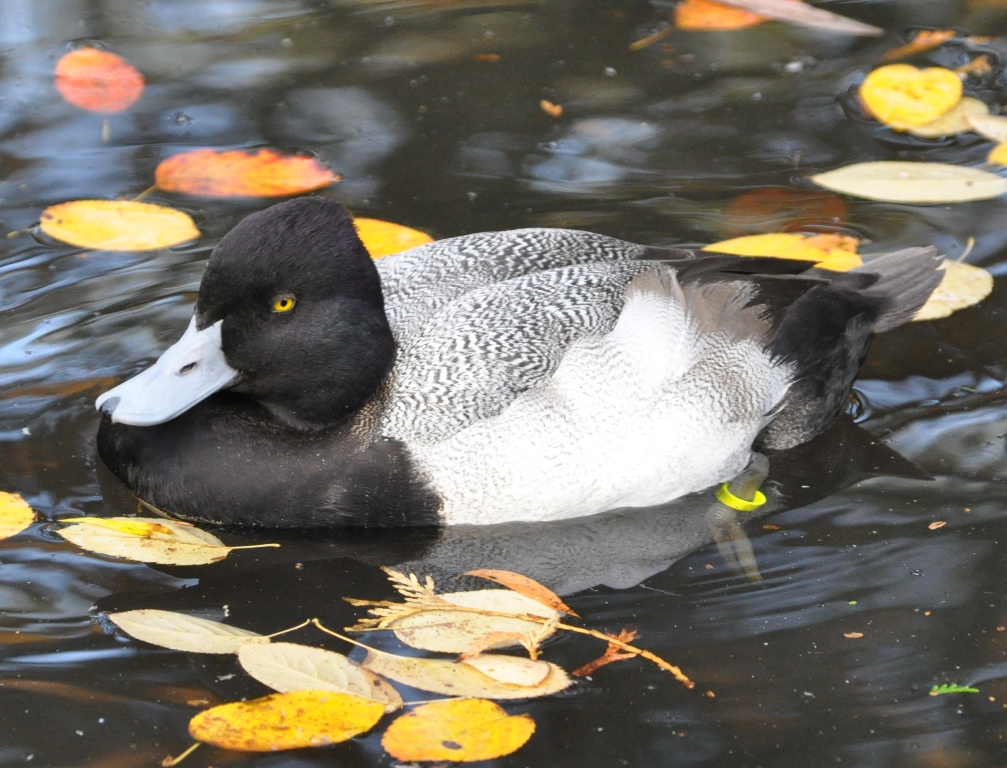
Lesser scaup(Aythya affinis)
Phylum —chordata
Class — aves
Order — anseriformes
Family — anatidae
Genus –aythya
Appearance
Adults are 38–48 cm (15–19 in) long, 41.7–43 cm (16.4–16.9 in) on average. The species can weigh 454–1,089 g (1.001–2.401 lb). The wingspan is 68–78 cm (27–31 in).
The adult males (drakes) in alternate plumage have a black, iridescent head and a small tuft at the hindcrown, a black breast, a whitish-grey back and wings with darker vermiculations and black outer and greyish-brown inner primary remiges. The underparts are white with some olive vermiculations on the flanks, and the rectrices and tail coverts are black. Adult females (hens) have a white band at the base of the bill, often a lighter ear region, and are otherwise dark brown all over, shading to white on the mid-belly. Drakes in eclipse plumage look similar, but with a very dark head and breast, little or no white on the head and usually some greyish vermiculations on the wings. Immature birds resemble the adult females, but are duller and have hardly any white at the bill base. Both sexes have white secondary remiges, a blue-grey bill with a black "nail" at the tip and grey feet; the drakes have a bright yellow iris, while that of females is orange or amber and that of immatures is brown.
Habitat
The lesser scaup is a North American duck that migrates south as far as Central America in winter.
Behavior
Lesser scaup are social, non-aggressive birds. They are tolerant of conspecifics except for the early breeding season, when males defend their female mates. In winter they form large flocks for molting and migration. Flocks as large as 500,000 have been reported. They are active during the day.
Diet
Lesser scaup adults and young eat insects, crustaceans, and mollusks. They sometimes also take the seeds of aquatic plants. Diet varies with the seasonal availability of food and regionally.
Reproduction
Lesser scaup are monogamous. Pairs are formed during late spring migration and last only until the females have been incubating the eggs for some time.
Most individuals arrive on breeding grounds by May and nesting and egg-laying activity peaks in June.
Females lay from 6 to 14 pale, greenish eggs in a clutch. They lay 1 egg per day until the clutch is complete and begin incubating a day or two before the final egg is laid. Some females lay eggs in the nests of other females. Males abandon their female mates on the nest in mid to late June, about mid-way through incubation, which lasts 21 to 27 days. Only females incubate the eggs and care for the young after hatching.
Young are precocial at hatching and can feed themselves. Females lead their brood away from the nest within a day of hatching. Young feed from the water surface initially, but feed by diving by 2 weeks old. Females attend their brood for 2 to 5 weeks after hatching, often abandoning them before they begin to fly.
The maximum recorded lifespan in the wild is 18 years, 4 months.
In captivity
These are quite social birds, so they should be kept in small groups.
Their diet must necessarily include aquatic insects and crustaceans. In addition, it is recommended to give shellfish and plants: lettuce stalks and leaves, wild celery, sedge seeds.
Lesser scaup likes water, and the farm should have a reservoir up to 1.5 m deep.
The banks of reservoirs should be filled with pebbles and gravel. This is necessary for building a bird's nest. It is desirable that the territory contains shrubs or reeds along the banks of the reservoir. This is a necessary condition for the rest of the bird.
This duck is migratory, so the cage with ducks should have a mesh roof.
 Russian
Russian
 English
English
























